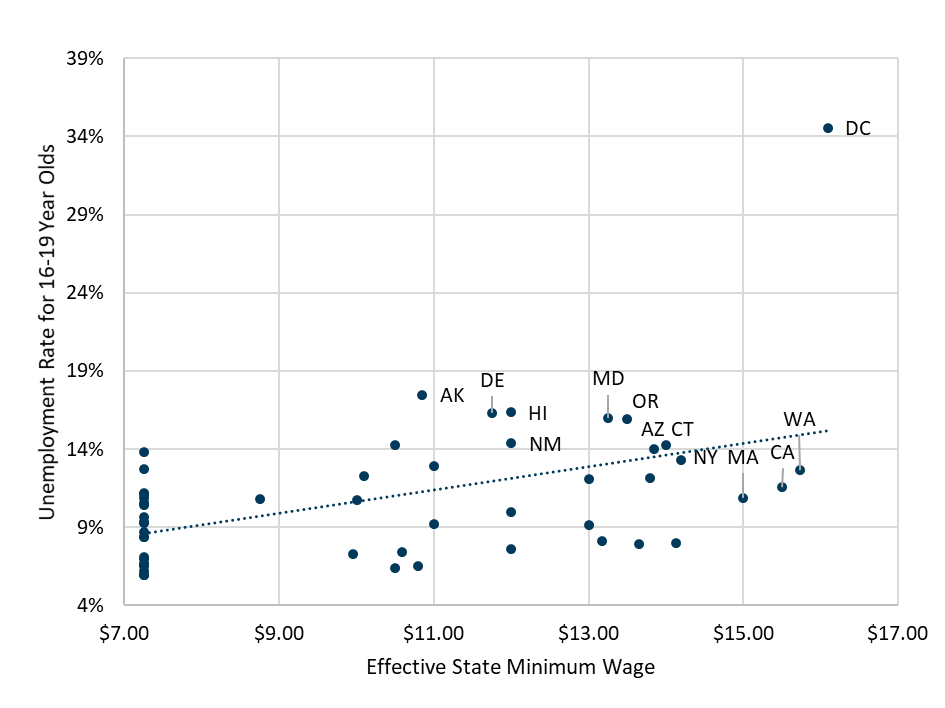Economists agree that major minimum wage hikes cost employees their jobs – especially for teens. The most recent data from the U.S. Census Bureau shows this happening in real time: states with the largest minimum wages in the nation are also experiencing the highest unemployment rates for workers aged 16 to 19.
Analysis of monthly Census Bureau data on teen unemployment and labor force statistics over the last year shows that some of the nation’s highest minimum wage states – Oregon, New York, Washington, California, and Connecticut – are experiencing higher-than-average rates of unemployment for resident teenagers. Washington, D.C. is experiencing a whopping near-35% teen unemployment rate.

The following tables show the highest and lowest February 2023 average unemployment rates for 16 to 19 year olds by state with effective minimum wage rates.
Top 10 Highest Teen Unemployment States
| State | February 2023 Average Unemployment Rate | Effective State Minimum Wage |
| District of Columbia | 34.6% | $16.10 |
| Alaska | 17.5% | $10.85 |
| Hawaii | 16.4% | $12.00 |
| Delaware | 16.3% | $11.75 |
| Maryland | 16.0% | $13.25 |
| Oregon | 15.9% | $13.50 |
| New Mexico | 14.4% | $12.00 |
| Connecticut | 14.2% | $14.00 |
| Nevada | 14.2% | $10.50 |
| Arizona | 14.0% | $13.85 |
Lowest Teen Unemployment States
| State | February 2023 Average Unemployment Rate | Effective State Minimum Wage |
| North Dakota | 7.1% | $7.25 |
| Alabama | 6.9% | $7.25 |
| Utah | 6.7% | $7.25 |
| Wisconsin | 6.7% | $7.25 |
| South Dakota | 6.5% | $10.80 |
| Mississippi | 6.5% | $7.25 |
| Nebraska | 6.4% | $10.50 |
| New Hampshire | 6.2% | $7.25 |
| Idaho | 6.0% | $7.25 |
| Iowa | 5.9% | $7.25 |
The U.S. average unemployment rate for 16 to 19 year olds was 10.6%.
The average minimum wage of states with the top ten unemployment rates (ranging from 13.8% to 34.6% teen unemployment) was $12.78 per hour, while the average wage for ten states with the lowest unemployment rates (ranging from 5.9% to 7.1% unemployment) was $7.93 per hour.
While there are various factors that contribute to youth unemployment, this new data concurs with a larger body of research on the effects of minimum wage hikes on employment loss, especially for youth. A survey of American labor economists found three-quarters agreed a $15 minimum wage would have negative employment effects on teenagers.
A 2018 Mercatus Center report from economists David Neumark and Cortnie Shupe found increasing minimum wages to be the “predominant factor” impacting youth joblessness since the turn of the century. A 2021 study by economists William Even and David Macpherson of Miami and Trinity Universities found that the largest share of job losses (42%) stemming from a proposed $15 federal minimum wage would be borne by teenagers. A 2022 review of three decades of minimum wage research by Neumark and Peter Shirley also finds that while an overwhelming majority of studies find employment loss consequences as a result of wage hikes, the effects are even stronger for teens and young adults.
As the school year draws to a close, many states with progressive minimum wage hikes could be leaving their teens without a job this summer.
